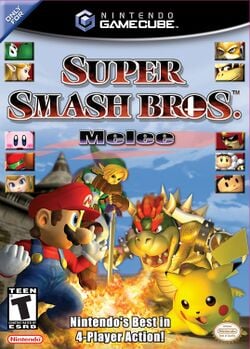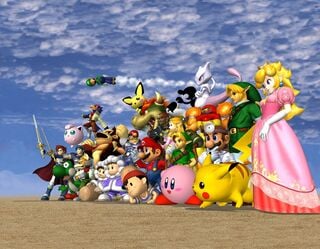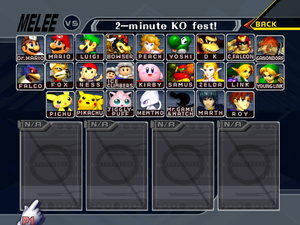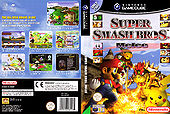Super Smash Bros. Melee
| “ | Within Nintendo, we've had a lot of discussion about which of our most popular characters should be ready to appear in games when Nintendo GameCube comes to market. We think we've got a great answer. | ” |
| Super Smash Bros. Melee | |
|---|---|

| |
| Developer(s) | HAL Laboratory |
| Publisher(s) | Nintendo |
| Designer(s) | Masahiro Sakurai |
| Released | |
| Genre(s) | Fighting game |
| Mode(s) | Single-player, Multiplayer (2-4) |
| Ratings | ESRB: T ELSPA: 11+ ELSPA: 3+ (re-rating) PEGI: 3+ OFLC: G8+ |
| Platform(s) | Nintendo GameCube |
| Media | GameCube Optical Disc |
| System requirements | 11 blocks of memory (an additional 2 or more blocks are needed for each snapshot saved) |
- "Melee" redirects here. For the game mode, see Versus Mode.
Super Smash Bros. Melee, known in Japan as Dairantou* Smash Brothers DX** (大乱闘 スマッシュ ブラザーズDX, Dairantō Sumasshu Burazāzu Dī Ekkusu), and often shortened to "SSBM" or "Melee", is a 2.5D fighting game for the Nintendo GameCube. It was released in late 2001 in America and Japan, shortly after GameCube's launch, and early 2002 in Europe. It is the second game in the Super Smash Bros. series, following its predecessor, Super Smash Bros. and was succeeded by Super Smash Bros. Brawl.
Like Super Smash Bros., its predecessor, Melee features gameplay unique from that of other fighting games. Compared to characters in other fighting games, Melee characters have simple movesets and lack complicated button inputs and lengthy natural combos. Instead Melee emphasizes movement and ringouts. Indeed, edge-guarding in Melee takes on much more significance than it does in most other games due to copious mid-air jumps and other methods of reaching the edge unfettered.
* Dairantou = Great Fray
**DX = Deluxe
Opening Movie
The opening movie of Melee was given particularly high attention by the developing team; according to Sakurai, the team wanted to create an entire, high-quality FMV sequence in the game in order to highlight the then newly-released GameCube console's graphical power in comparison to previous consoles. The development team worked in three different animations studios in Tokyo, Japan to finish the FMV opening.
In addition to pre-rendered cutscenes, the opening sequence also contains some shots of actual gameplay; continuing the trend started in the previous game, the opening also directly segues into the title screen.
A beta opening has also been found; in this sequence, the clips of actual gameplay had been considerably changed.
<youtube>56P3-TwuRBo</youtube>
Characters
The cast of 25 playable characters, 26 includng Zelda's alter ego Sheik, includes all twelve characters from Super Smash Bros. and thirteen newcomers. Of these, fourteen are available from the start of play, including all the "veteran" characters bar Luigi and Jigglypuff.
Of the new characters, the greatest number are from the The Legend of Zelda universe if Zelda/Sheik are counted as two characters to go with Ganondorf and Young Link; although the Mario series also takes three new character slots for Bowser, Princess Peach and Dr. Mario added. On top of these, two universes add two characters each, with the Fire Emblem series making its Smash Bros. debut with Marth & Roy; and the Pokémon universe adding Mewtwo & Pichu to its two existing characters. The three other characters added are Falco, a second character from the Star Fox series, and Mr. Game & Watch & the Ice Climbers from two highly venerable Nintendo series.
Starter characters
- File:MarioSymbol(preBrawl).png Bowser
- File:FZeroSymbol.png Captain Falcon
- File:DKSymbol(preBrawl).png Donkey Kong
- File:StarFoxSymbol(preBrawl).png Fox
- File:IceClimbersSymbol.png Ice Climbers
- File:KirbySymbol.png Kirby
- File:ZeldaSymbol.png Link
- File:MarioSymbol(preBrawl).png Mario
- File:EarthboundSymbol.png Ness
- File:PokemonSymbol(preBrawl).png Pikachu
- File:MarioSymbol(preBrawl).png Peach
- File:MetroidSymbol(preBrawl).png Samus
- File:YoshiSymbol(preBrawl).png Yoshi
- File:ZeldaSymbol.png Zelda/Sheik
Unlockable characters
- File:MarioSymbol(preBrawl).png Dr. Mario*
- File:StarFoxSymbol(preBrawl).png Falco
- File:ZeldaSymbol.png Ganondorf
- File:PokemonSymbol(preBrawl).png Jigglypuff
- File:MarioSymbol(preBrawl).png Luigi
- File:FireEmblemSymbol.png Marth
- File:PokemonSymbol(preBrawl).png Mewtwo*
- File:Game&WatchSymbol(preBrawl).png Mr. Game & Watch
- File:PokemonSymbol(preBrawl).png Pichu*
- File:FireEmblemSymbol.png Roy*
- File:ZeldaSymbol.png Young Link*
Non-Playable Characters (all playable using Action Replay)
- File:SmashBrosSymbol.png Giga Bowser
- File:SmashBrosSymbol.png Master Hand (Except by glitch)
- File:SmashBrosSymbol.png Crazy Hand
- File:SmashBrosSymbol.png Sandbag
- File:SmashBrosSymbol.png Fighting Wire Frames*
* Characters that did not return in Super Smash Bros. Brawl.
Stages
There are eighteen starter stages and eleven more which can be unlocked.
Default stages
- File:MetroidSymbol(preBrawl).png Brinstar*
- File:StarFoxSymbol(preBrawl).png Corneria*
- File:KirbySymbol.png Fountain of Dreams
- File:ZeldaSymbol.png Great Bay
- File:KirbySymbol.png Green Greens*
- File:IceClimbersSymbol.png Icicle Mountain
- File:DKSymbol(preBrawl).png Jungle Japes*
- File:DKSymbol(preBrawl).png Kongo Jungle
- File:MarioSymbol(preBrawl).png Mushroom Kingdom
- File:FZeroSymbol.png Mute City
- File:EarthboundSymbol.png Onett*
- File:PokemonSymbol(preBrawl).png Pokémon Stadium*
- File:MarioSymbol(preBrawl).png Princess Peach's Castle
- File:MarioSymbol(preBrawl).png Rainbow Cruise*
- File:ZeldaSymbol.png Temple*
- File:StarFoxSymbol(preBrawl).png Venom
- File:YoshiSymbol(preBrawl).png Yoshi's Island*
- File:YoshiSymbol(preBrawl).png Yoshi's Story
Unlockable stages
- File:SmashBrosSymbol.png Battlefield
- File:FZeroSymbol.png Big Blue*
- File:MetroidSymbol(preBrawl).png Brinstar Depths
- File:KirbySymbol.png Dream Land**
- File:SmashBrosSymbol.png Final Destination
- File:Game&WatchSymbol(preBrawl).png Flat Zone
- File:EarthboundSymbol.png Fourside
- File:MarioSymbol(preBrawl).png Mushroom Kingdom II
- File:DKSymbol(preBrawl).png Kongo Jungle**
- File:PokemonSymbol(preBrawl).png Poké Floats
- File:YoshiSymbol(preBrawl).png Yoshi's Island**
* stages return in Super Smash Bros. Brawl.
** stages return from Super Smash Bros..
Single-Player stages
These stages cannot be unlocked, and can only be played under certain circumstances.
- Target Test Stages
- Trophy Collector
- Race to the Finish
- Mushroom Kingdom Adventure
- Underground Maze
- Brinstar Escape Shaft
- F-Zero Grand Prix
- Rest Station
- Home-Run Stadium
- Majora's Mask
- Goomba
- Entei
Debug-Only Stages
These stages can only be used when the game is hacked. Some are functional, most are not.
Functional
- TEST
- Zelda/Sheik's Target Test Stage
Non-Functional
* Can be activated with other hacks, but not Debug Mode.
Modes
1-Player
- Classic Mode
- Adventure Mode
- All-Star Mode (must be unlocked)
- Event Match
- Stadium
- Training
Multi-player
Action Replay
Unlockables
The game features several points to be unlocked, most of which include the trophies, unlockable characters and stages. Some of them are unlocked by a special way, like achieving a certain distance on the Home-Run Contest, while others are obtained by the Lottery. For a full list, see List of unlockables in Melee.
Reception
| Melee reviews | |
|---|---|
| Publication | Score |
| Edge Magazine | 6/10 |
| Eurogamer | 10/10[1] |
| Famitsu | 37/40 |
| GameSpot | 8.9/10[2] |
| IGN | 9.6/10[3] |
| Nintendo Power | 5/5 [4][5] |
| Official Nintendo Magazine | 95% |
| Compilations of multiple reviews | |
| Metacritic | 92/100[4] |
| Game Rankings | 90.30%[5] |
Melee was well-received in many quarters and is the GameCube's top-selling game. More than seven-million copies of Melee were sold as of March 10, 2008.
Changes from the original
While Melee mainly follows the same formula introduced in the original game by retaining most elements, several differences exist between the two games. The following list, while not all-inclusive, notes several of the changes. Note that this list does not include obvious changes, such as a different button scheme/controller and Melee-only characters and items.
- The general pacing of the game has been increased; freeze frames have been reduced, KOs off the top blast line finish sooner, and characters move faster in general (especially vertically).
- Attack physics now use spheres and tubes instead of cubes.
- Damage is now dealt and tracked with decimal numbers instead of integers, making moves of any damage equally vulnerable to staleness.
- Angle indicators have been removed.
- Stale-move negation has been redesigned; moves now feature a gradual drop in power if used repeatedly instead of a single large drop in power when used once, and using a move less frequently but still often gives less of a penalty then using the move the same number of times consecutively.
- Weight is approximately half as important to the knockback characters receive; the lighter characters from SSB sustain less knockback (Jigglypuff and Kirby are examples of this). The heavier characters from SSB sustain more knockback (Donkey Kong is an example of this as well).
- The amount of hitstun a character suffers has been slightly decreased. Reduced from .5 to .46.
- Smash attacks can now be charged for extra damage and knockback. Most smash attacks have received a power decrease to balance this out (Captain Falcon, Pikachu, and Jigglypuff are the only characters to have at least one or two smash attacks' power increased; Falcon is the only character to have all three smash attacks' power increased).
- Meteor smashes can now be cancelled, though certain moves "fall through the cracks" and cannot be. Most meteor smashes now take longer to execute.
- Characters now have a side special move, bringing the total number of special moves per character to 4. Some veterans gain a new move for their side special, while others gain a new neutral special, with their old one becoming the side special.
- Characters can now sidestep dodge and air dodge, which results in the removal of shield platform dropping and the addition of wavedashing.
- Characters can now powershield and lightshield.
- Characters can now tech on walls and ceilings.
- Characters now have a unique animation for running grabs, which is generally slower and further-reaching than their standing/walking grab.
- Jump-canceled grabs are implemented. These are similar to dash grabs, but are faster, has bigger hitboxes, and depends on how high or low the character's traction is.
- Grabs can now be escaped should the grabber wait too long before throwing, depending on the victim's damage.
- Characters now have an up throw and a down throw in addition to a pummel. Some veterans have had throws reassigned (for example, Kirby and Jigglypuff's old forward throws are now their up throws, and they gained new forward throws).
- Throws are weaker in general, with less damage and knockback. This introduces many chain throws.
- Certain characters can now use their extended grab in midair and wall grapple.
- Certain characters can now wall jump.
- Moonwalking is possible (characters like C. Falcon and Link are notable for having this).
- Items can now be grabbed before coming to rest, and can also now be grabbed by aerial characters.
- All characters can walk while holding a heavy item, though very slowly; Donkey Kong remains the only one who can jump.
- Maxim Tomatoes now only heal 50%; Heart Containers now only heal 100%.
- The Board the Platforms bonus game has been replaced with the Snag the Trophies bonus game.
- Unique On-Screen Appearances have been removed; all characters share the same animation of a trophy coming to life.
- A stock match can now have a maximum time limit set.
- Bonuses can now be earned in both single-player modes and multiplayer matches.
- Statistics are not saved if a game is quit.
- The camera controls on the pause screen have been extended to allow freedom of focusing on other characters and moving about the stage.
- 1P Game is now known as Classic Mode, and various other single-player modes (such as Adventure Mode and All-Star Mode) have been added.
Tournament play
Melee is widely known for its large and intricate tournament scene. The generally accepted birth of the tournament scene was caused by the creation of the Tournament Go series. Recently, the tournament scene has been bolstered by grand-scale tournaments such as the MLG series.
The community has constructed a set of standard tournament rules to regulate tournament play. All matches are played with timed stock (usually four lives and eight minutes), with items turned off and restrictions on legal stages. These regulations are enacted to ensure that gameplay at the highest level remains fair and interesting.
Gallery
Trivia
- Super Smash Bros. Melee marks the first playable appearance on the Nintendo GameCube for 25 out of the 26 playable characters. The only character who had been playable on the GameCube beforehand was Luigi in Luigi's Mansion.
- Despite there being 5 "?"-marked character boxes initially, there are a total of 11 unlockable characters, with the ones not marked by a "?" being clones. Given that Melee directly identifies these characters as clones by how they're presented on the selection screen, this raises interesting questions about how they were treated by the development team.
- Oddly enough, when Luigi becomes unlocked, he takes his place beside Mario and bumps Pikachu down into a "?" box. Pikachu being sandwiched in the Mario section in the first place appears to have been done so the bottom-row placement of the "?" boxes is aesthetically pleasing without having to move anything else around.
- Melee became the best-selling game for the GameCube.
- Melee is the only game in the series where Ness and Captain Falcon are starter characters. They were unlockable characters for the rest of the games in the series.
References
- ^ http://www.eurogamer.net/articles/r_ssbm_gc
- ^ http://uk.gamespot.com/gamecube/action/supersmashbrosmelee/
- ^ http://uk.cube.ign.com/articles/166/166387p1.html
- ^ a b http://www.metacritic.com/game/gamecube/super-smash-bros-melee
- ^ a b http://www.gamerankings.com/gamecube/516492-super-smash-bros-melee/index.html



